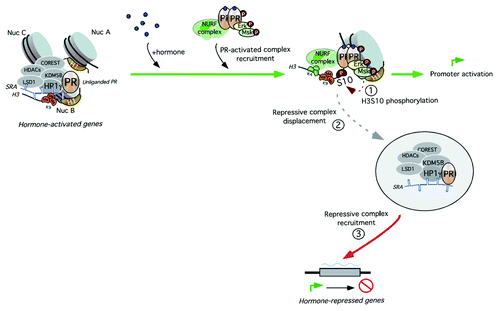Figures & data
Figure 1. An SRA-containing repressive complex is involved in basal gene repression. In the absence of hormone, the repressive complex HP1γ-LSD1.com is bound to genomic target sites through the operation of three factors: i) the unliganded receptor, ii) its associated ncRNA SRA and iii) the H3K9me3. In the presence of hormone, activated MSK1 phosphorylates H3 at serine 10 and promotes HP1γ-LSD1.com eviction from target regions and recruitment to hormone-repressed genes. Whether the same complex participates in both derepression and active repression is still under investigation. Displacement of the repressive complex allows H3 to be trimethylated at K4 and acetylated at K14, both marks required for NURF and BAF loading and hormonal-dependent gene activation.Citation9,Citation31
